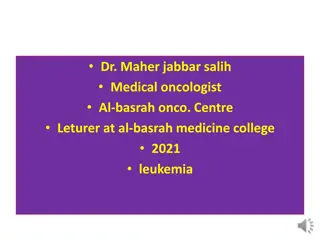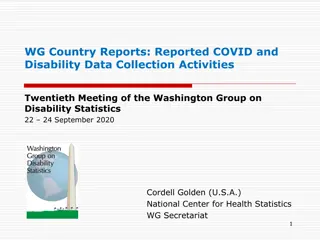Assertion Collection in DICOM Working Group 07 Radiotherapy
The Assertion Collection IOD addresses the need to collect assertions outside DICOM Instances, providing contextual and identification information. It aims to collect assertions for DICOM Instances during clinical procedures, providing meta information about assertions and allowing for self-contained Instances. Real-world decisions can be recorded separately from image data, avoiding duplication. Trace of Assertions showcases how images are added, reviewed, and approved within Assertion Collection Instances. The process involves combining instances into Reference Collections, making real-world decisions, and tracking changes over multiple instances.
Download Presentation

Please find below an Image/Link to download the presentation.
The content on the website is provided AS IS for your information and personal use only. It may not be sold, licensed, or shared on other websites without obtaining consent from the author.If you encounter any issues during the download, it is possible that the publisher has removed the file from their server.
You are allowed to download the files provided on this website for personal or commercial use, subject to the condition that they are used lawfully. All files are the property of their respective owners.
The content on the website is provided AS IS for your information and personal use only. It may not be sold, licensed, or shared on other websites without obtaining consent from the author.
E N D
Presentation Transcript
Supplement 238 Assertion Collection DICOM Working Group 07 Radiotherapy
Motivation With an increasing number of DICOM Instances from different modalities for a single patient visit and related assertions for them, such as approval, the need to collect these assertions outside the actual Instances arises. The Assertion Collection IOD addresses these issues, along with providing contextual information for the assertion and identification information for the referenced Instances. 2
Scope Collect assertions for DICOM Instances during a clinical procedure or workflow Provide meta information who made which assertion and when Provide contextual information, so that the Assertion Collection Instance is self-contained and does not require further evaluation of referenced Instances 3
Real-World Process The Assertion Collection allows to combine Instances or groups of Instances (Studies or Series) in so-called Reference Collections. It is then possible to record real-world decisions (e.g. added to/removed from Reference Collection, unreviewed/reviewed, approved/unapproved/rejected, ) for these Reference Collections. Keeping this record separate to the Instances, Series and Studies makes it possible to avoid duplicating images and collection of images to change assertion information for the images. 4
Trace of Assertions A CT and an MR Series are acquired and Dr. Frank N. Stein adds them to an Assertion Collection Instance. In addition, Dr. Stein co-registers the image data sets and also adds a Registration Instance. Assertion Collection 1 CT Series: Added; Dr. Stein, Frank. N. (Resident); Nov 14, 2022 MR Series: Added; Dr. Stein, Frank. N. (Resident); Nov 14, 2022 Registration A: Added; Dr. Stein, Frank. N. (Resident); Nov 14, 2022 Registration A CT MR 5
Trace of Assertions The next day, the image Series are approved for further use by Dr. Acula, but he is not satisfied with performed registration and rejects the Registration Instance. Dr. Acula co-registers the image data sets again, and adds and approves the new Registration by creating a new Assertion Collection Instance the references the Instance of the prior day. Assertion Collection 2 CT Series: Approved; Dr. Acula (Attending); Nov 15, 2022 MR Series: Approved; Dr. Acula (Attending); Nov 15, 2022 Registration A: Removed; Dr. Acula (Attending); Nov 15, 2022 Registration B: Added, Approved; Dr. Acula (Attending); Nov 15, 2022 Predecessor: Assertion Collection 1 CT MR Registration A Registration B 6
Trace of Assertions Based on this result, the ACME Segmenter Software automatically creates Segmentation Instances and adds them to a new Assertion Collection along with the existing Reference Collections. Assertion Collection 3 CT Series: Approved; Dr. Acula (Attending); Nov 15, 2022 MR Series: Approved; Dr. Acula (Attending); Nov 15, 2022 Registration B: Added, Approved; Dr. Acula (Attending); Nov 15, 2022 Segmentation: Added, ACME Segmenter Software; Nov 16, 2022 Predecessor: Assertion Collection 2 CT MR Registration A Registration B Segmentation - Segment 1 - Segment 2 7
Trace of Assertions Dr. Acula then approves Segment 1 for further clinical usage, but rejects Segment 2 by creating another Assertion Collection Instance, which again references the Instance from the day before. Assertion Collection 4 CT Series: Approved; Dr. Acula (Attending); Nov 15, 2022 MR Series: Approved; Dr. Acula (Attending); Nov 15, 2022 Registration B: Added, Approved; Dr. Acula (Attending); Nov 15, 2022 Segmentation-Segment 1: Approved; Dr. Acula (Attending); Nov 17, 2022 Segmentation-Segment 2: Rejected; Dr. Acula (Attending); Nov 17, 2022 Predecessor: Assertion Collection 3 CT MR Registration A Registration B Segmentation - Segment 1 - Segment 2 8
Main Editor Christof Schadt Co-Chair DICOM WG-07 christof.schadt@brainlab.com Solomon - Analysis objects 9























